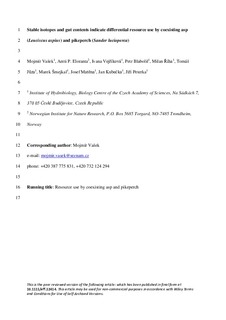Stable isotopes and gut contents indicate differential resource use by coexisting asp (Leuciscus aspius) and pikeperch (Sander lucioperca)
Vašek, Mojmír; Eloranta, Antti; Vejříková, Ivana; Blabolil, Petr; Říha, Milan; Jůza, Tomáš; Šmejkal, Marek; Matěna, Josef; Kubečka, Jan; Peterka, Jiří
Journal article, Peer reviewed
Accepted version

Åpne
Permanent lenke
http://hdl.handle.net/11250/2504538Utgivelsesdato
2018Metadata
Vis full innførselSamlinger
- Publikasjoner fra CRIStin - NINA [2364]
- Scientific publications [1392]
Originalversjon
10.1111/eff.12414Sammendrag
Differential use of habitat and prey resources is an important mechanism that may allow coexistence of sympatric species. Unlike interactions between smaller cyprinid and percid fishes, the resource use by coexisting predatory asp (Leuciscus aspius) and pikeperch (Sander lucioperca) is relatively unknown. Here, gut content and stable isotope analyses were used to study ontogenetic dietary shifts and interspecific trophic niche overlap between asp and pikeperch coexisting in two reservoirs. The hypothesis that both species show an ontogenetic dietary shift from small invertebrates to large fish prey, but at the same time use different prey resources to reduce potential competitive interactions, was validated. The isotopic niches of the two predators showed no, or only a moderate, degree of overlap (0%–65%). The ontogenetic changes in the degree of interspecific isotopic niche overlap were different in the two reservoirs, suggesting that trophic segregation can be dynamic and variable among systems. Gut contents revealed that small (<100 mm standard length) asp consumed mostly terrestrial invertebrates and emerged aquatic insects, whereas small pikeperch foraged on zooplankton, larval and pupal stages of aquatic insects and fish. Larger individuals (>100 mm) of both species were predominantly piscivorous, with asp consuming more cyprinid prey and pikeperch more percid prey. Coexisting asp and pikeperch populations are able to utilise different prey resources, thereby reducing potential negative competitive interactions. dietary ontogeny, foraging strategy, interspecific competition, piscivory, stable isotopes